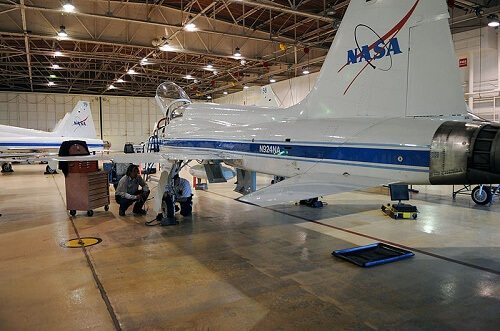 IMAGE SOURCE: Wikimedia Commons, public domain
IMAGE SOURCE: Wikimedia Commons, public domain
Overview
They may not spend as much time in the cockpit as airline pilots do, but avionics technicians are an essential part of the aviation industry. These specialists maintain, inspect and repair aircraft components such as software, electronic instruments and electrical control panels. Without them, airplanes’ radar systems, navigation systems and radio communications would be unreliable.
Aerospace product and parts manufacturing is the industry that employs the most avionics technicians, followed by support services for air transportation, the federal government and scheduled air transportation. Though avionics technicians typically work near a major airport, their exact workplaces vary from hangars to airfields. Avionics technicians need to work well with both computers and hand and power tools to complete the necessary tasks required for keeping airplanes in reliable working order. Some of their work is part of an aircraft’s scheduled maintenance, while other times they must repair unanticipated problems.
Avionics technicians use a variety of equipment types, including oscilloscopes, circuit testers and voltmeters to assess the electronic instruments onboard an aircraft. They put together and install instrument panels and electrical controls. An avionics technician must be as comfortable installing computer software as he or she is using soldering irons, hand tools and power tools to connect instrument panels. When a plane malfunctions in some way, avionics technicians analyze data from test flights to first determine what caused the problem and then to fix it.
Education
While a college degree is not yet an absolute requirement for attaining an entry-level avionics technician job, it provides an important advantage in what can be a competitive career field. Earning an associate’s degree in a program such as computer repair of aviation flight instruments is a valuable first step to entering this occupation, especially as aircraft controls and equipment become ever more complex. Related military experience, too, is a plus that can help aspiring avionics technicians get started in their careers.
In addition to an associate’s degree, aspiring avionics technicians should attend a Part 147 program at an Aviation Maintenance Technician School approved by the Federal Aviation Administration (FAA). At the end of such a training and education program, graduates receive a certificate of completion that is the first step to earning FAA certification. Some avionics technicians seek an Airframe rating certification from the FAA, just as aircraft mechanics do. Others become certified through the repair station that employs them and are certified only to complete specific work. Avionics technicians may also seek radio-telephone operator certification from the Federal Communications Commission (FCC) or Aircraft Electronics Technician (AET) certification from the National Center for Aerospace and Transportation Technologies.
Employment
Avionics technicians earn a median salary of $55,210 per year, according to the United States Bureau of Labor Statistics (BLS). Although this occupation is not considered to be a fast-growing field, candidates who earn a bachelor’s degree rather than simply the required associate’s degree are better equipped to find jobs in a competitive economy and to advance to higher-level positions than their less educated peers. The best career opportunities are likely to go to candidates who have a thorough understanding of computers, digital systems and new technology, the BLS reported.
Conclusion
Today’s aircraft include complex digital, computer and electronics systems and equipment. Avionics technicians are the specialists in charge of maintaining and repairing this equipment to make sure planes can fly, navigate and communicate safely and reliably. They handle both mechanical work, in assembling and installing control panels, and computer work, in installing software.
